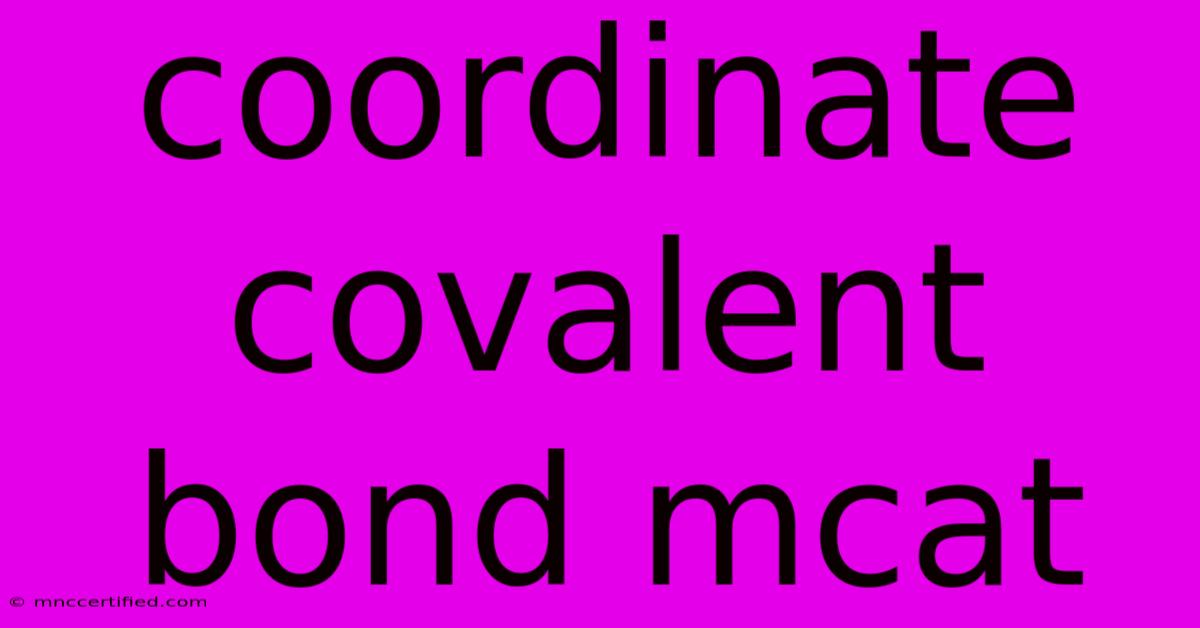Coordinate Covalent Bond Mcat

Table of Contents
Conquering the Coordinate Covalent Bond: Your MCAT Cheat Sheet
The MCAT loves to test your understanding of chemical bonding, and coordinate covalent bonds are a frequent visitor on the exam. Understanding these bonds is crucial for success in the chemistry and biochemistry sections. This article will break down everything you need to know about coordinate covalent bonds for the MCAT, ensuring you're prepared to tackle any question thrown your way.
What is a Coordinate Covalent Bond?
A coordinate covalent bond, also known as a dative bond, is a type of covalent bond where both electrons shared in the bond come from the same atom. This contrasts with a regular covalent bond, where each atom contributes one electron to the shared pair. The key difference lies in the origin of the electrons.
Think of it like this: in a regular covalent bond, both partners contribute equally. In a coordinate covalent bond, one atom is the generous donor, providing both electrons, while the other acts as the grateful acceptor.
Identifying Coordinate Covalent Bonds
The easiest way to identify a coordinate covalent bond is to look for a Lewis structure where one atom provides both electrons for the shared pair. These bonds often involve a Lewis acid (electron acceptor) and a Lewis base (electron pair donor).
Example: The formation of the ammonium ion (NH₄⁺) from ammonia (NH₃) and a hydrogen ion (H⁺) is a classic example. Ammonia, with its lone pair of electrons on the nitrogen atom, acts as a Lewis base. The hydrogen ion, lacking electrons, acts as a Lewis base. The nitrogen atom donates both electrons to form a coordinate covalent bond with the hydrogen ion.
Lewis Acids and Bases: The Key Players
Understanding Lewis acids and bases is critical to grasping coordinate covalent bonds.
-
Lewis Acid: An electron-pair acceptor. Often, these are species with an incomplete octet or a positive charge, seeking electrons to achieve stability. Examples include H⁺, BF₃, and AlCl₃.
-
Lewis Base: An electron-pair donor. These species possess a lone pair of electrons that they can share. Examples include NH₃, H₂O, and Cl⁻.
The reaction between a Lewis acid and a Lewis base always involves the formation of at least one coordinate covalent bond.
Coordinate Covalent Bonds in Biochemistry
Coordinate covalent bonds play a significant role in many biologically important molecules and reactions. Some key examples include:
-
Hemoglobin: The iron ion in hemoglobin forms coordinate covalent bonds with the nitrogen atoms of the porphyrin ring and with a histidine residue in the globin protein. This interaction is vital for oxygen binding.
-
Enzyme-Substrate Complexes: Many enzymes utilize coordinate covalent bonds to bind substrates, facilitating catalysis. The metal ions in metalloenzymes often form coordinate covalent bonds with the substrate.
-
Metal-Ligand Complexes: Metal ions in biological systems often form coordinate covalent bonds with various ligands (molecules or ions that bond to the metal ion). These complexes play crucial roles in various biological processes.
MCAT-Style Questions and Strategies
The MCAT will likely test your understanding of coordinate covalent bonds through various question types, including:
-
Identifying coordinate covalent bonds in Lewis structures. Practice drawing Lewis structures and identifying which bonds are coordinate covalent.
-
Understanding the role of Lewis acids and bases. Be prepared to identify Lewis acids and bases in reactions involving coordinate covalent bond formation.
-
Applying your knowledge to biological systems. Understand the importance of coordinate covalent bonds in hemoglobin, enzyme function, and other biochemical processes.
-
Distinguishing between coordinate covalent and regular covalent bonds. Focus on the origin of the shared electrons as the key differentiator.
Mastering the Concept: Practice and Review
Consistent practice is key to mastering coordinate covalent bonds for the MCAT. Use practice questions and review materials to solidify your understanding and identify areas where you need further attention. Focus on understanding the underlying principles rather than rote memorization.
By focusing on the fundamental concepts discussed here, understanding the role of Lewis acids and bases, and practicing with MCAT-style questions, you'll be well-equipped to conquer the coordinate covalent bond on exam day. Remember, consistent effort and a deep understanding will lead you to success!

Thank you for visiting our website wich cover about Coordinate Covalent Bond Mcat. We hope the information provided has been useful to you. Feel free to contact us if you have any questions or need further assistance. See you next time and dont miss to bookmark.
Featured Posts
-
Liverpool 2 0 Real Madrid Loss
Nov 28, 2024
-
Injuries Force Slots Klopp Strategy Liverpool
Nov 28, 2024
-
Groucho Club Closure Follows Serious Crime
Nov 28, 2024
-
Aston Villa Vs Juventus Lineups
Nov 28, 2024
-
Black Friday Wsl Deal Aston Villa Clash
Nov 28, 2024